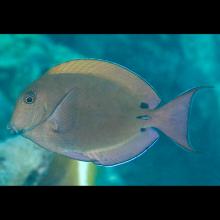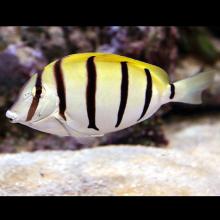Acanthurus nigrofuscus
Common name:
Lavender tang
Genus:
Acanthurus
Family:
Acanthuridae
Suborder:
Percoidei
Acanthurus triostegus
Common name:
Convict surgeonfish
Genus:
Acanthurus
Family:
Acanthuridae
Suborder:
Percoidei
Acanthurus nigrofuscus
Common name:
Lavender tang
Genus:
Acanthurus
Family:
Acanthuridae
Suborder:
Percoidei
Acanthurus triostegus
Common name:
Convict surgeonfish
Genus:
Acanthurus
Family:
Acanthuridae
Suborder:
Percoidei
Acanthurus nigrofuscus
Common name:
Lavender tang
Genus:
Acanthurus
Family:
Acanthuridae
Suborder:
Percoidei
Acanthurus triostegus
Common name:
Convict surgeonfish
Genus:
Acanthurus
Family:
Acanthuridae
Suborder:
Percoidei
Family (Animalia): Acanthuridae
Acanthuridae are the family of surgeonfishes, tangs, and unicornfishes. The family includes about 86 extant species of marine fish living in tropical seas, usually around coral reefs. Many of the species are brightly colored and popular in aquaria.
The distinctive characteristic of the family is that they have scalpel-like modified scales, one or more on either side of the peduncle of the tail. The spines are dangerously sharp and may seriously injure anyone who carelessly handles such a fish. The dorsal, anal, and caudal fins are large, extending for most of the length of the body. The mouths are small and have a single row of teeth adapted to grazing on algae.
Surgeonfishes sometimes feed as solitary individuals, but they often travel and feed in schools. Feeding in schools may be a mechanism for overwhelming the highly aggressive defense responses of small territorial damselfishes that vigorously guard small patches of algae on coral reefs.
Most species are fairly small, with a maximum length of 15–40 cm (6–15.5 in), but some in the genus Acanthurus, some in the genus Prionurus, and most species in the genus Naso may grow larger; the whitemargin unicornfish (Naso annulatus) is the largest species in the family, reaching a length of up to 1 m (3 ft 3 in). These fishes may grow quickly in aquaria, so average growth size and suitability should be checked before adding them to any marine aquarium.
Etymology and Taxonomic History
The name of the family is derived from the Greek words akantha and oura, which loosely translate to "thorn" and "tail", respectively. This refers to the distinguishing characteristic of the family, the "scalpel" found on the caudal peduncle. In the early 1900s, the family was called Hepatidae.
In the Aquarium
Tangs are very sensitive to disease in the home aquarium. However, if the tang is fed enough algae and the aquarium is properly maintained disease should not be a problem. It is usually necessary to quarantine the animals for a period before introducing them to the aquarium.
Adults range from 15 to 40 centimetres (5.9 to 15.7 in) in length and most grow quickly even in aquaria. When considering a tang for an aquarium it is important to consider the size to which these fish can grow. Larger species such as the popular Pacific blue tang surgeonfish (of Finding Nemo fame), Naso or lipstick tang, lined surgeonfish, Sohal surgeonfish and Atlantic blue tang surgeonfish can grow to 40 cm (16 in) and require swimming room and hiding places.
Many also suggest adding aggressive tangs to the aquarium last as they are territorial and may fight and possibly kill other fish.
Tangs primarily graze on macroalgae from genera such as Caulerpa and Gracilaria, although they have been observed in an aquarium setting to eat meat-based fish foods. A popular technique for aquarists, is to grow macroalgae in a sump or refugium. This technique not only is economically beneficial, but serves to promote enhanced water quality through nitrate absorption. The growth of the algae can then be controlled by feeding it to the tang.
Reference: Wikipedia


